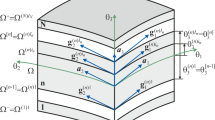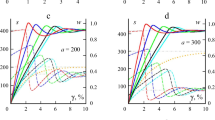We solve the problems of finding the stress state near through defects (cracks or thin rigid inclusions) in an infinite cylinder of any cross section under the conditions of oscillations of longitudinal shear. We propose an approach that enables one to separately satisfy the conditions imposed on the surfaces of the defects and on the boundary of the body. Approximate relations for the stress intensity factors are obtained and the influence of the frequencies of oscillations, type of the defects, and their location on the values of the stress intensity factors are investigated by using the indicated relations.
Similar content being viewed by others
References
S. M. Belotserkovskii and I. K. Lifanov, Numerical Methods in Singular Integral Equations and Their Application in Aerodynamics, Theory of Elasticity, and Electrodynamics [in Russian], Nauka, Moscow (1985).
A. A. Bobylev and Yu. A. Dobrova, “Application of the boundary-element method to the numerical analyses of forced vibrations of the elastic bodies of finite sizes with cracks,” Visn. Kharkiv Univ., No. 590, Ser. Mat. Model., Inform. Technol., Avtom. Syst., Issue 1, 49–54 (2003).
N. P. Vekua, Systems of Singular Integral Equations and Some Boundary-Value Problems [in Russian], Nauka, Moscow (1970).
V. I. Krylov, Approximate Calculation of Integrals [in Russian], Nauka, Moscow (1967).
V. V. Mykhas’kiv and O. M. Khai, “Time boundary integral equations in the three-dimensional problems of diffraction of elastic waves on thin rigid inclusions,” Dopov. Nats. Akad. Nauk Ukrainy, No. 6, 66–71 (2001).
V. V. Mykhas’kiv and M. V. Khai, “Solution of dynamic problems of the theory of elasticity for bodies with cracks by means of the Fourier transformation,” Dokl. Akad. Nauk Ukr. SSR, Ser. A, No. 11, 27–30 (1987).
Z. T. Nazarchuk, Numerical Investigation of Wave Diffraction on Cylindrical Structures [in Russian], Naukova Dumka, Kiev (1989).
V. G. Popov, “Interaction of elastic waves of longitudinal shear with radially located cracks,” Prikl. Mekh., 34, No. 2, 60–66 (1998).
V. G. Popov, “Investigation of the fields of displacements and stresses in the case of diffraction of shear elastic waves on thin rigid exfoliated inclusions,” Izv. Ross. Akad. Nauk, Mekh. Tverdogo Tela, No. 3, 139–146 (1992).
V. G. Popov, “Comparison of the fields of displacements and stresses in the case of diffraction of shear elastic waves on different defects: a crack and a thin rigid inclusion,” Dinam. Sist., Issue 12, 35–41 (1993).
V. E. Poruchikov, Methods of the Dynamic Theory of Elasticity [in Russian], Nauka, Moscow (1986).
H. T. Sulym, Foundations of the Mathematical Theory of Thermoelastic Equilibrium of Deformed Bodies with Thin Inclusions [in Ukrainian], Doslidno-Vydavnychyi Tsentr NTSh, Lviv (2007).
D. D. Ang and L. Knopoff, “Diffraction of scalar elastic waves by a finite crack,” Proc. Nat. Acad. Sci. USA, 51, No. 4, 593–598 (1964).
F. Chirino and J. Dominguez, “Dynamic analysis of cracks using boundary element method,” Eng. Fract. Mech., 34, No. 5-6, 1051–1061 (1989).
P. Fedelinski, M. H. Aliabadi, and D. P. Rooke, “A single-region time domain BEM for dynamic crack problems,” Int. J. Solids Struct., 32, No. 24, 3555–3571 (1995).
P. Hosseini-Tehrani, A. R. Hosseini-Godarzi, and M. Tavangar, “Boundary element analysis of stress intensity factor K I in some two-dimensional dynamic thermoelastic problems,” Eng. Anal. Bound. Elem., 29, No. 3, 232–240 (2005).
J. F. Loeber and G. C. Sih, “Diffraction of antiplane shear waves by a finite crack,” J. Acoust. Soc. Am., 44, No. 1, 90–98 (1968).
A. K. Mal, “Interaction of elastic waves with a Griffith crack,” Int. J. Eng. Sci., 8, No. 9, 763–776 (1970).
I. Nistor, O. Pantalé, and S. Caperaa, “Numerical implementation of the extended finite element method for dynamic crack analysis,” Adv. Eng. Softw., 39, No. 7, 573–587 (2008).
C. Zhang, “A 2D hypersingular time-domain traction BEM for transient elastodynamic crack analysis,” Wave Motion, 35, No. 1, 17–40 (2002).
G. Zi, H. Chen, J. Xu, and T. Belytschko, “The extended finite element method for dynamic fractures,” Shock Vib., 12, No. 1, 9–23 (2005).
Author information
Authors and Affiliations
Additional information
Translated from Matematychni Metody ta Fizyko-Mekhanichni Polya, Vol. 55, No. 3, pp. 61–71, July–September, 2012.
Rights and permissions
About this article
Cite this article
Kyrylova, O.I., Popov, V.G. Stress state in an infinite cylinder of any cross section with tunnel defect under harmonic oscillations of longitudinal shear. J Math Sci 194, 198–212 (2013). https://doi.org/10.1007/s10958-013-1520-5
Received:
Published:
Issue Date:
DOI: https://doi.org/10.1007/s10958-013-1520-5




